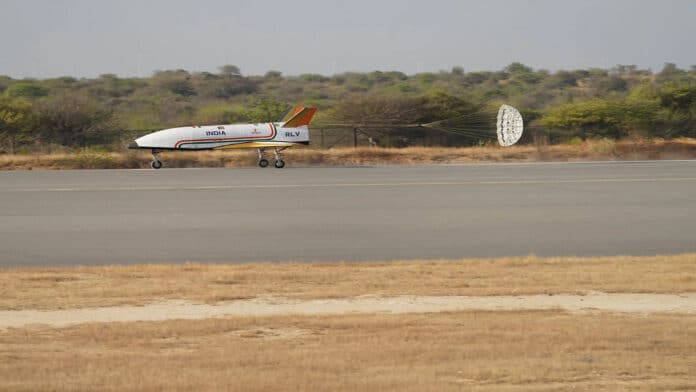The Indian Space Research Organization (ISRO) has successfully completed the autonomous landing test as part of its Reusable Launch Vehicle Autonomous Landing Mission (RLV LEX) program. The test was conducted at the Aeronautical Test Range (ATR), Chitradurga, Karnataka, on Sunday, April 2, 2023.
During the test, the RLV-TD took off by a Chinook Helicopter of the Indian Air Force as an underslung load and flew to a height of 4.5 km (2.7 miles). Once the predetermined pillbox parameters were attained, the RLV was released autonomously in mid-air at a down range of 4.6 km (2.8 miles).
The RLV then performed approach and landing maneuvers using the Integrated Navigation, Guidance, and control system and completed an autonomous landing on the ATR airstrip. This allowed the space agency of India to successfully achieve the autonomous landing of a space vehicle.
ISRO stated that the autonomous landing was carried out under the exact conditions of a Space Re-entry vehicle’s landing as if the vehicle arrived from space. The team successfully achieved landing parameters such as Ground relative velocity, the sink rate of Landing Gears, and precise body rates, as might be experienced by an orbital re-entry space vehicle in its return path.
India’s space agency added that its experiment was the world’s first, as a winged body has been carried for the first time to an altitude of 4.5 km by a helicopter and released for carrying out an autonomous landing on a runway. The RLV is essentially a space plane with a low lift-to-drag ratio requiring an approach at high glide angles that necessitated a landing at high velocities of 350 km/h (217 mph).
The LEX utilized several indigenous systems, such as localized navigation systems based on pseudolite systems, instrumentation, sensor systems, etc., developed by ISRO.
“Digital Elevation Model (DEM) of the landing site with a Ka-band Radar Altimeter provided accurate altitude information. Adaptation of contemporary technologies developed for RLV LEX turns other operational launch vehicles of ISRO more cost-effective. Extensive wind tunnel tests and CFD simulations enabled aerodynamic characterization of RLV prior to the flight,” ISRO said.
“The winged RLV-TD has been configured to act as a flying test bed to evaluate various technologies, namely, hypersonic flight, autonomous landing, and powered cruise flight. In the future, this vehicle will be scaled up to become the first stage of India’s reusable two-stage orbital launch vehicle,” ISRO said in its statement.
ISRO demonstrated the re-entry of its winged vehicle RLV-TD in the HEX mission in May 2016. The re-entry of a hypersonic sub-orbital vehicle marked a major accomplishment in developing Reusable Launch Vehicles. The vehicle landed on a hypothetical runway over the Bay of Bengal in HEX. Precise landing on a runway was an aspect not included in the HEX mission. The LEX mission achieved the final approach phase that coincided with the re-entry return flight path exhibiting an autonomous, high-speed (350 km/h) landing. The LEX began with an Integrated Navigation test in 2019 and followed multiple Engineering Model Trials and Captive Phase tests in subsequent years.
